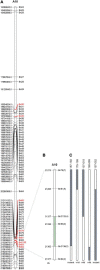Fine Mapping of a Locus Underlying the Ectopic Blade-Like Outgrowths on Leaf and Screening Its Candidate Genes in Rapeseed (Brassica napus L.)
- PMID: 33584757
- PMCID: PMC7874103
- DOI: 10.3389/fpls.2020.616844
Fine Mapping of a Locus Underlying the Ectopic Blade-Like Outgrowths on Leaf and Screening Its Candidate Genes in Rapeseed (Brassica napus L.)
Abstract
Leaf is an important organ for higher plants, and the shape of it is one of the crucial traits of crops. In this study, we investigated a unique aberrant leaf morphology trait in a mutational rapeseed material, which displayed ectopic blade-like outgrowths on the adaxial side of leaf. The abnormal line 132000B-3 was crossed with the normal line 827-3. Based on the F2 : 3 family, we constructed two DNA pools (normal pool and abnormal pool) by the bulked segregant analysis (BSA) method and performed whole genome re-sequencing (WGR), obtaining the single-nucleotide polymorphism (SNP) and insertion/deletion (InDel) data. The SNP-index method was used to calculate the Δ(SNP/InDel-index), and then an association region was identified on chromosome A10 with a length of 5.5 Mbp, harboring 1048 genes totally. Subsequently, the fine mapping was conducted by using the penta-primer amplification refractory mutation system (PARMS), and the associated region was narrowed down to a 35.1-kbp segment, containing only seven genes. These seven genes were then analyzed according to their annotations and finally, BnA10g0422620 and BnA10g0422610, orthologs of LATE MERISTEM IDENTITY1 (LMI1) gene from Arabidopsis and REDUCED COMPLEXITY (RCO) gene from its relative Cardamine hirsuta, respectively, were identified as the candidate genes responding to this blade-like outgrowth trait in rapeseed. This study provides a novel perspective into the leaf formation in Brassica plants.
Keywords: Brassica napus; LATE MERISTEM IDENTITY1; REDUCED COMPLEXITY; aberrant leaf; fine mapping; whole genome re-sequencing.
Copyright © 2021 Chai, Feng, Liu, Jiang, Yuan, Zhang, Li, Zhang, Fernando, Xu, Cui, Jiang, Zheng and Wu.
Conflict of interest statement
The authors declare that the research was conducted in the absence of any commercial or financial relationships that could be construed as a potential conflict of interest.
Figures




Similar articles
-
Promoter variations in a homeobox gene, BnA10.LMI1, determine lobed leaves in rapeseed (Brassica napus L.).Theor Appl Genet. 2018 Dec;131(12):2699-2708. doi: 10.1007/s00122-018-3184-5. Epub 2018 Sep 15. Theor Appl Genet. 2018. PMID: 30219987
-
Identification and Fine Mapping of a Locus Related to Leaf Up-Curling Trait (Bnuc3) in Brassica napus.Int J Mol Sci. 2021 Oct 28;22(21):11693. doi: 10.3390/ijms222111693. Int J Mol Sci. 2021. PMID: 34769127 Free PMC article.
-
Identification of genomic regions associated with multi-silique trait in Brassica napus.BMC Genomics. 2019 Apr 23;20(1):304. doi: 10.1186/s12864-019-5675-4. BMC Genomics. 2019. PMID: 31014236 Free PMC article.
-
Characterization and fine mapping of a new dwarf mutant in Brassica napus.BMC Plant Biol. 2021 Feb 26;21(1):117. doi: 10.1186/s12870-021-02885-y. BMC Plant Biol. 2021. PMID: 33637037 Free PMC article.
-
Fine mapping of an up-curling leaf locus (BnUC1) in Brassica napus.BMC Plant Biol. 2019 Jul 19;19(1):324. doi: 10.1186/s12870-019-1938-0. BMC Plant Biol. 2019. PMID: 31324149 Free PMC article.
Cited by
-
Salt tolerant Pseudomonas taiwanensis PWR-1 in combination with a reduced dose of mineral fertilizers improves the nutritional and antioxidant properties of wheatgrass grown in saline soil.World J Microbiol Biotechnol. 2023 Nov 13;40(1):11. doi: 10.1007/s11274-023-03806-x. World J Microbiol Biotechnol. 2023. PMID: 37953356
-
Mapping and Screening of Candidate Gene Regulating the Biomass Yield of Sorghum (Sorghum bicolor L.).Int J Mol Sci. 2024 Jan 8;25(2):796. doi: 10.3390/ijms25020796. Int J Mol Sci. 2024. PMID: 38255870 Free PMC article.
References
-
- Doyle J., Doyle J. (1990). Isolation of plant DNA from fresh tissues. Focus 12 13–15.
LinkOut - more resources
Full Text Sources
Other Literature Sources
Miscellaneous

